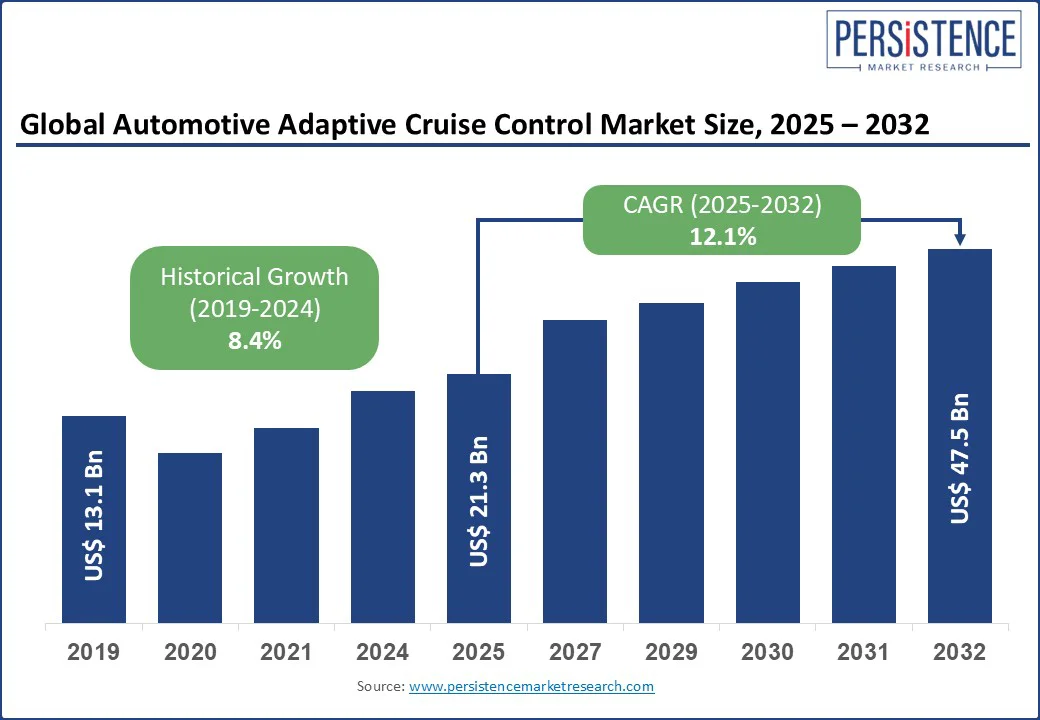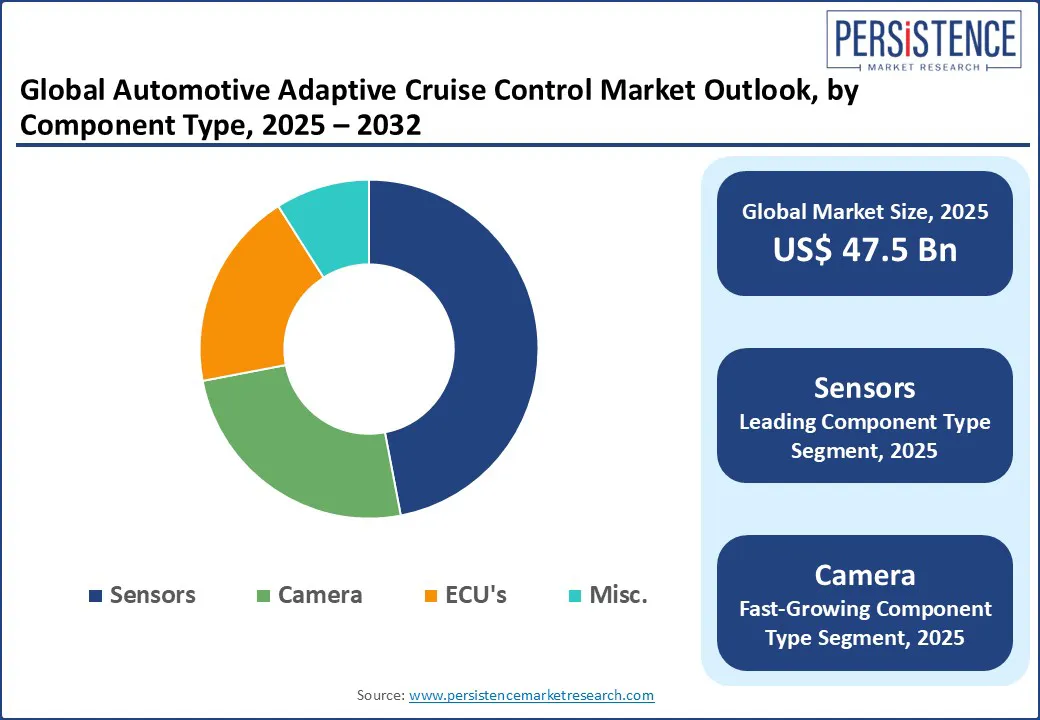ID: PMRREP34862| 197 Pages | 24 Jul 2025 | Format: PDF, Excel, PPT* | Automotive & Transportation

The global automotive adaptive cruise control market size is likely to be valued at US$ 21.3 Bn in 2025 and reach US$ 47.5 Bn by 2032, growing at a CAGR of 12.1% during the forecast period from 2025 to 2032. The global automotive adaptive cruise control market is driven by the rising demand for advanced driver-assistance systems (ADAS) in passenger and commercial vehicles. Innovation in sensor fusion, AI-enabled perception, and real-time object detection are enhancing system accuracy and performance. Sustainability efforts are also accelerating adoption, especially with energy-efficient electronic control units and lightweight sensor modules.

Key Industry Highlights:
| Global Market Attribute | Key Insights |
| Automotive Adaptive Cruise Control Market Size (2025E) | US$ 21.3 Bn |
| Market Value Forecast (2032F) | US$ 47.5 Bn |
| Projected Growth (CAGR 2025 to 2032) | 12.1% |
| Historical Market Growth (CAGR 2019 to 2024) | 8.4% |
The global adoption of adaptive cruise control (ACC) is primarily driven by increasingly stringent vehicle safety regulations and mandates for advanced driver assistance systems (ADAS). In North America and the European Union, governments now require the installation of features such as ACC, which help maintain safe following distances to reduce rear-end collisions. The U.S. National Highway Traffic Safety Administration (NHTSA) states that ACC can reduce rear-end collisions by up to 40%. By making ACC a legal requirement, policymakers are effectively encouraging automakers to integrate these systems into both mass-market and premium models, leading to widespread implementation.
Technological innovation significantly boosts the impact of ACC systems. Breakthroughs in sensor fusion, integrating radar, camera, and LiDAR data, along with real-time AI-enabled object recognition, enhance reliability and cost-effectiveness. For instance, Valeo produced 20 million front camera systems using Mobileye EyeQ technology by December 2023, doubling their previous milestone and improving ACC readiness. As costs decrease, manufacturers can standardize ACC in more affordable vehicles, supporting compliance with safety regulations. These elements, including mandated safety standards and advancing sensor-AI technology, drives the market forward.
Adaptive Cruise Control (ACC) systems often face operational limitations due to inconsistent road infrastructure. Poor lane markings, worn traffic signs, and insufficient Vehicle-to-Infrastructure (V2I) communication networks in emerging markets can significantly degrade ACC performance and customer trust. For instance, INRIX reported urban areas surpassing pre-pandemic congestion levels in 2022, exacerbating sensor dependency on clear lane delineation and digital connectivity.
ACC is vulnerable to failure in adverse weather conditions, such as heavy rain, fog, snow, or dust, which can reduce sensor detection accuracy by 45-50%. This inconsistency affects safety and user confidence, compelling automakers to add calibrations and redundancies, thus increasing development complexity. These challenges, along with poor infrastructure and sensor unreliability, hinder ACC adoption, especially in regions with suboptimal roads and unpredictable climates. Significant investment in digital road infrastructure and stronger sensors is needed to unlock future market opportunities.
Adaptive Cruise Control (ACC) is set to become a key part of connected, semi-autonomous driving systems, thanks to advancements in artificial intelligence (AI), vehicle-to-everything (V2X) communication, and the increased use of electric vehicles. AI-powered sensor fusion combines data from radar, LiDAR, and cameras, allowing ACC systems to learn from driving patterns, predict traffic behavior, and enhance both fuel efficiency and safety. For example, companies such as Bosch, Nvidia, and Valeo are developing solutions that adapt to changing conditions and reduce emissions by optimizing speed continuity.
The government-backed rollout of V2X infrastructure presents a significant opportunity. In the U.S., the FCC allocated 30 MHz in the 5.9 GHz band for cellular-V2X, showing strong federal support for connected transport systems. This enables ACC-equipped vehicles to communicate with traffic signals, pedestrians, and each other, improving predictive behavior and collision avoidance. ACC's smooth speed control also conserves battery life, enhancing the range of electric vehicles as their adoption grows. OEMs integrating ACC into mid-range electric and hybrid models can tap into a vast market potential.
Sensors are the leading component segment in the automotive adaptive cruise control (ACC) market, holding approximately a 47% share. This dominance is due to their essential role in accurate environment perception and real-time decision-making. Among the various types of sensors, radar is the most widely used, thanks to its reliable performance, cost-effectiveness, and ability to function well in challenging conditions such as fog, rain, and low light. Radar provides precise distance and speed measurements, which are crucial for ensuring safe longitudinal control.
Short- and mid-range radar modules are crucial for urban traffic, while long-range radar aids in high-speed cruising. Other sensors, like LiDAR and ultrasonic sensors, enhance capabilities such as 3D mapping and object detection. As safety regulations evolve to require collision warning and adaptive cruise features, radar's integration within the sensor ecosystem becomes essential for OEM strategies across all vehicle segments.
Passenger vehicles represent the most dynamic growth segment in the automotive adaptive cruise control (ACC) market, registering a robust CAGR of 12.6%, propelled by rising safety expectations and the wider rollout of driver assistance technologies. Within this segment, the hatchbacks and SUVs are emerging as key contributors to volume and adoption momentum. Hatchbacks are widely favored in densely populated urban centers, are increasingly equipped with compact ACC systems that enhance driver comfort in stop-and-go traffic. This trend is particularly evident in cost-sensitive markets such as India, Brazil, and Southeast Asia, where affordability and practicality are top consumer priorities.
Simultaneously, SUVs, especially compact and mid-size variants, are gaining traction as versatile platforms for ACC integration due to their global popularity and strong safety appeal. In regions such as Europe and North America, these models are now frequently offered with ACC as standard or optional, aligning with consumer demand for semi-autonomous driving features. For OEMs, hatchbacks and SUVs provide high-return, scalable pathways to expand ACC deployment across both emerging and mature markets.

Asia Pacific holds the leading share of around 38% in the global automotive adaptive cruise control market, primarily due to its dominant position in global vehicle production and the rapid integration of advanced driver-assistance systems (ADAS). Countries such as China, Japan, South Korea, and India are witnessing rising demand for both economy and premium vehicles equipped with semi-autonomous technologies. The region benefits from a strong supplier ecosystem, low-cost manufacturing capabilities, and rising consumer awareness regarding vehicle safety. OEMs operating in this region are also aggressively localizing sensor production and investing in ADAS-focused R&D to address both affordability and scale.
China is leading regional expansion in intelligent transportation systems, fueled by its position as the largest automotive market and increasing EV adoption. Automakers like BYD, NIO, and XPeng are equipping vehicles with comprehensive ADAS, including adaptive cruise systems. Japan and South Korea, with companies like Toyota, Honda, Hyundai, and Kia, are advancing radar and camera-based ACC systems through innovation and export strategies. In India, while ACC is mostly seen in upper-tier vehicles, growing urbanization and mid-range ADAS offerings from Tata Motors and Mahindra are projected to drive significant growth.
North America, particularly the United States is witnessing strong growth in the adaptive cruise control market with a CAGR of around 12.9%, driven by stringent safety mandates, a mature automotive ecosystem, and growing consumer demand for semi-autonomous driving features. The region is characterized by high penetration of premium and mid-premium vehicles, where ACC is increasingly offered as standard equipment. Regulatory bodies such as NHTSA and IIHS are pushing for greater adoption of automatic emergency braking and forward-collision avoidance systems, both of which are typically coupled with adaptive cruise functionality. The strong presence of global OEMs and ADAS technology providers ensures a high rate of product innovation and system reliability.
The U.S. remains the dominant market within North America due to its large volume of light trucks, SUVs, and luxury vehicles, all of which are key ACC-integrated segments. Leading automakers like Ford, General Motors, and Tesla are embedding adaptive cruise control in both ICE and electric platforms, making it increasingly mainstream. Canada, while smaller in size, follows closely in technology adoption, supported by a safety-conscious consumer base and favorable climate for semi-autonomous features.
Europe remains one of the most mature markets for automotive adaptive cruise control systems, backed by strong regulatory enforcement, premium vehicle penetration, and consumer inclination toward safety and driving comfort. The region commands a substantial market share, estimated at around 32%, driven largely by mandatory inclusion of advanced driver-assistance systems (including ACC) under the EU General Safety Regulation. European OEMs such as Mercedes-Benz, BMW, Audi, and Volvo are known pioneers in integrating radar and camera-based adaptive cruise technologies, offering these features across most model tiers. The region also leads in sensor innovation, with Tier-1 suppliers such as Bosch and Continental investing heavily in real-time perception and sensor fusion capabilities, further solidifying Europe's role as a technology enabler in the ACC space.
Germany leads Europe in adaptive cruise control (ACC) due to its strong luxury vehicle manufacturing and early adoption of Level 2 autonomy systems. Automakers are now standardizing ACC in mid-tier models to compete with EV disruptors and meet global safety standards. France and the UK are also advancing, supported by consumer awareness and national EV policies. Nordic countries like Sweden prioritize road safety and technology, with brands such as Volvo aiming for zero fatalities linked to systems like ACC. Overall, Europe's growth in this sector is driven by regulation, innovation, and the expansion of premium vehicles.

The global automotive adaptive cruise control market is characterized by intense competition as manufacturers invest in product innovation and regional diversification. Companies are integrating multi-sensor technologies, including radar, LiDAR, and cameras, to enhance decision-making in various road scenarios. This focus on advanced and cost-effective ACC systems drives OEMs to standardize features across their vehicle offerings. Collaborations with software and AI firms aim to advance adaptive cruise systems toward Level 2+ autonomy, making them relevant for the mass market. Future growth opportunities are seen in modular ACC architectures for EVs and hybrids.
ACC component procurement is becoming more specialized in terms of the supply chain, as suppliers optimize production close to important automotive hubs for faster delivery and greater customization. Distributors and Tier 1 vendors are enhancing logistics to reduce lead times, crucial for components like radar sensors and ECUs. This integrated approach is essential for supporting faster production cycles and quicker market deployment
The automotive adaptive cruise control market is set to reach US$ 21.3 Bn in 2025.
The Automotive Adaptive Cruise Control Market is driven by rising demand for advanced driver assistance systems (ADAS), government safety regulations, and increasing integration of autonomous features in vehicles.
The automotive adaptive cruise control market is estimated to rise at a CAGR of 12.1% from 2025 to 2032.
Key market opportunities include integrating ACC with autonomous driving, increasing adoption in mid-range vehicles, expanding use in commercial fleets, and rising demand in emerging markets due to safety and comfort preferences.
The major players dominating the global Automotive Adaptive Cruise Control Market are Robert Bosch GmbH, Continental AG, ZF Friedrichshafen AG, Denso Corporation, Magna International Inc., and Valeo SA.
| Report Attribute | Details |
| Historical Data/Actuals | 2019 - 2024 |
| Forecast Period | 2025 - 2032 |
| Market Analysis Units | Value: US$ Bn/Mn, Volume: As applicable |
| Geographical Coverage |
|
| Segmental Coverage |
|
| Competitive Analysis |
|
| Report Highlights |
|
| Customization and Pricing | Available upon request |
By Component Type
By Vehicle Type
By Region
Delivery Timelines
For more information on this report and its delivery timelines please get in touch with our sales team.
About Author